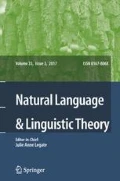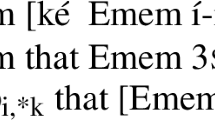Abstract
The unpronounced subject of infinitives, PRO, bears standard case, which is reflected on agreeing predicative elements in languages like Russian, Icelandic, Ancient Greek, etc. This case can be independent from the case of the controller DP, or identical to it (‘case transmission’). We report the findings of a novel study of case transmission in Russian, based on data collected from 30 speakers. The findings contradict some key generalizations that have gone unchallenged in the field for decades; specifically, case transmission is much more prevalent than previously assumed, often co-occurring with the option of independent case. The pattern of case transmission is determined by the interaction of a complex set of factors—the grammatical function of the controller, the shape of the complementizer, the type of control relation (exhaustive or partial), and more. The proposed analysis builds on “The Agreement Model of Obligatory Control (OC)” (Landau 2000, 2004, 2006) and strongly supports the claim that OC exploits two routes—either a direct Agree relation with PRO, or one mediated by the infinitival C. It is derivationally local and free of the “look-ahead” properties inherent to earlier accounts. Finally, we provide a description of the documented crosslinguistic variation in this domain, and situate it within a tight typological model.
Similar content being viewed by others
References
Andrews, Avery D. 1971. Case agreement of predicate modifiers in Ancient Greek. Linguistic Inquiry 2: 127–151.
Andrews, Avery D. 1976. The VP-complement analysis in Modern Icelandic. In NELS 6: proceedings of the 6th meeting of the North Eastern Linguistic Society, eds. Joan Maling, and Annie Zaenen, 1–21. Amherst: GLSA. [Reprinted in Modern Icelandic syntax, eds. Joan Maling and Annie Zaenen. Vol. 24 of Syntax and semantics, 165–185. San Diego: Academic Press.].
Andrews, Avery D. 1982. The representation of case in Modern Icelandic. In The mental representation of grammatical relations, ed. Joan Bresnan, 424–503. Cambridge: MIT Press.
Andrews, Avery D. 1990. Case structures and control in Modern Icelandic. In Modern Icelandic syntax, eds. Joan Maling, and Annie Zaenen. Vol. 24 of Syntax and semantics, 187–234. San Diego: Academic Press.
Babby, Leonard H. 1991. Noncanonical configurational case assignment strategies. In Cornell working papers in linguistics, vol. 9, eds. Almeida Toribio, and Wayne Harbert, 1–55. Ithaca: Cornell University Press.
Babby, Leonard H. 1998. Subject control as direct predication: evidence from Russian. In Proceedings of the 6th meeting of formal approaches to Slavic linguistics, eds. Željko Boškovič, Steven Franks, and William Snyder, 17–37. Ann Arbor: Michigan Slavic Publications.
Babby, Leonard H., Steven Franks. 1998. The syntax of adverbial participles in Russian revisited. Slavic and East European Journal 42: 117–149.
Bailyn, John F. 2001. The syntax of Slavic predicate case. In ZAS occasional papers in linguistics, vol. 22, eds. Gerhard Jäger, Anatoli Strigin, Chris Wilder, and Niina Zhang, 1–26. Berlin: Zentrum für Allgemeine Sprachwissenschaft.
Baker, Mark. 1988. Incorporation: a theory of grammatical function changing. Chicago: University of Chicago Press.
Baker, Mark. 1996. The polysynthesis parameter. New York: Oxford University Press.
Bobaljik, Jonathan, and Idan Landau. 2007. Icelandic control is not A-movement: the case from case. Linguistic Inquiry (to appear).
Boeckx, Cedric, and Norbert Hornstein. 2006. Control in Icelandic and theories of control. Linguistic Inquiry 37: 591–606.
Bošković, Željko. 1994. D-structure, theta-criterion and movement into theta-positions. Linguistic Analysis 24: 247–286.
Bošković, Željko. 2001. On the nature of the syntax-phonology interface: cliticization and related phenomena. Oxford: Elsevier Science.
Bošković, Željko, and Howard Lasnik. 2003. On the distribution of null complementizers. Linguistic Inquiry 34: 527–546.
Carnie, Andrew, and Heidi Harley. 1997. PRO, the EPP and nominative case: evidence from Irish infinitivals. In University of Pennsylvania working papers in linguistics, vol. 4, eds. Charles Boberg, Miriam Meyerhoff, and Stephanie Strassel, 71–86.
Cecchetto, Carlo, and Renato Oniga. 2004. A challenge to null case theory. Linguistic Inquiry 35: 141–149.
Chomsky, Noam. 1980. On binding. Linguistic Inquiry 11: 1–46.
Chomsky, Noam. 1981. Lectures on government and binding. Berlin: Mouton de Gruyter.
Chomsky, Noam. 2000. Minimalist inquiries: the framework. In Step by step: essays on minimalist syntax in honor of Howard Lasnik, eds. Roger Martin, David Michaels, and Juan Uriagereka, 89–155. Cambridge: MIT Press.
Chomsky, Noam. 2001. Derivation by phase. In Ken Hale: a life in language, ed. Michael Kenstowicz, 1–52. Cambridge: MIT Press.
Comorovski, Ileana. 1985. Control and obviation in Romanian. In ESCOL 2: proceedings of the eastern states conference on linguistics, eds. Soonja Choi, Dan Devitt, Wynn Janis, Terry McCoy, and Zheng-Sheng Zhang, 47–56. Ithaca: CLC Publications.
Comrie, Bernard. 1974. The second dative: a transformational approach. In Slavic transformational syntax, Michigan Slavic materials, No. 10, eds. Richard Brecht, and Catherine Chvany, 123–150. Ann Arbor: Michigan University Press.
Fleisher, Nicholas. 2006. Russian dative subjects, case and control. Manuscript, University of California, Berkeley.
Franks, Steven. 1990. Case, configuration and argumenthood: reflections on the second dative. Russian Linguistics 14: 231–254.
Franks, Steven. 1995. Parameters of Slavic morphosyntax. New York: Oxford University Press.
Franks, Steven. 1998. Parameters of Slavic morphosyntax revisited: a minimalist retrospective. In Proceedings of the 6th meeting of formal approaches to Slavic linguistics, eds. Željko Boškovič, Steven Franks, and William Snyder, 134–165. Ann Arbor: Michigan Slavic Publications.
Franks, Steven, and Norbert Hornstein. 1992. Secondary predication in Russian and proper government of PRO. In Control and grammar, eds. Richard Larson, Sabine Iatridou, Utpal Lahiri, and James Higginbotham, 1–50. Dordrecht: Kluwer.
Fukui, Naoki. 1999. An A-over-A perspective on locality. In Linguistics: in search of the human mind, ed. Kazuko Inoue, 109–129. Tokyo: Kaytakusha.
Gallego, Ángel J., and Juan Uriagereka. 2007. Conditions on sub-extraction. In Coreference, modality, and focus, eds. Luis Eguren, and Olga Fernández Soriano, 45–70. Amsterdam: John Benjamins.
Gonzalez, Nora. 1990. Unusual inversion in Chilean Spanish. In Studies in relational grammar, eds. Paul Postal, and Brian Joseph, 87–103. Chicago: University of Chicago Press.
Greenberg, Gerald R. 1983. Another look at the second dative and related subjects. Linguistic Analysis 11: 167–218.
Greenberg, Gerald R. 1989. Dative subjects and the second dative within Slavic. Digest for Philology and Linguistics 32: 45–57.
Greenberg, Gerald R., and Steven Franks. 1991. A parametric approach to dative subjects and the second dative in Russian. Slavic and East European Journal 35: 71–97.
Haeberli, Eric. 2003. Categorial features as the source of EPP and abstract case phenomena. In New perspectives on case theory, eds. Ellen Brandner, and Heike Zinsmeister, 89–126. Stanford: CSLI Publications.
Harley, Heidi. 1995. Subjects, events and licensing. PhD Dissertation, MIT.
Harley, Heidi. 2000. Irish, the EPP and PRO. Manuscript, University of Arizona, Tucson.
Holmberg, Andres, and Thorbjörg Hróarsdóttir. 2003. Agreement and movement in Icelandic raising constructions. Lingua 113: 997–1019.
Hornstein, Norbert. 2003. On control. In Minimalist syntax, ed. Randall Hendrick, 6–81. Oxford: Blackwell Publishing.
Hudson, Richard. 2003. Case agreement, PRO and structure sharing. Research in Language 1: 7–33.
Jackendoff, Ray, and Peter W. Culicover. 2003. The semantic basis of control in English. Language 79: 517–556.
Kawasaki, Noriko. 1993. Control and arbitrary interpretation in English. PhD Dissertation, University of Massachusetts, Amherst.
Lakoff, George. 1970. Global rules. Language 46: 627–639.
Landau, Idan. 2000. Elements of control: structure and meaning in infinitival constructions. Dordrecht: Kluwer.
Landau, Idan. 2003. Movement out of control. Linguistic Inquiry 34: 471–498.
Landau, Idan. 2004. The scale of finiteness and the calculus of control. Natural Language and Linguistic Theory 22: 811–877.
Landau, Idan. 2006. Severing the distribution of PRO from case. Syntax 9: 153–170.
Landau, Idan. 2007. Movement-resistant aspects of control. In New horizons in the analysis of control and raising, eds. William D. Davies, and Stanley Dubinsky, 293–325. Dordrecht: Springer.
Larson, Richard. 1988. On the double object construction. Linguistic Inquiry 19: 335–391.
Lyngfelt, Benjamin. 1999. Optimal control: an OT perspective on the interpretation of PRO in Swedish. Working Papers in Scandinavian Syntax 63: 75–104.
Madariaga, Nerea. 2006. Why Russian semi-predicative items always agree. Journal of Slavic Linguistics 14: 45–78.
Marantz, Alec. 1993. Implications of asymmetries in double object constructions. In Theoretical aspects of Bantu grammar, ed. Sam A. Mchombo, 113–150. Stanford: CSLI Publications.
Marantz, Alec. 2000. Case and licensing. In Arguments and case: explaining Burzio’s generalization, ed. Eric Reuland, 11–30. Amsterdam: John Benjamins.
McFadden, Thomas. 2004. The position of morphological case in the derivation: a study on the syntax-morphology interface. PhD dissertation, University of Pennsylvania.
Mulder, René. 1991. An empty head for object control. In Proceedings of the twenty first annual meeting of the North Eastern Linguistic Society, ed. Tim Sherer, 293–307. Amherst: GLSA Publications.
Neidle, Carol. 1982. Case agreement in Russian. In The mental representation of grammatical relations, ed. Joan Bresnan, 391–426. Cambridge: MIT Press.
Neidle, Carol Jan. 1988. The role of case in Russian syntax. Dordrecht: Kluwer.
Park, Jong-Un, and Myung-Kwan Park. 2004. Intervention effects in experiencer constructions and their implications for the theory of Move and Agree. Studies in Generative Grammar 14: 199–224.
Pesetsky, David. 1991. Zero syntax II: an essay on infinitives. Manuscript, MIT.
Przepiórkowski, Adam, and Alexandr Rosen. 2005. Czech and Polish raising/control with or without structure sharing. Research in Language 3: 33–66.
Pylkkänen, Liina. 2002. Introducing arguments. PhD dissertation, MIT.
Quicoli, Antonio C. 1982. The structure of complementation. Brussels: E. Story-Scientia Gent.
Richards, Norvin. 1998. The principle of minimal compliance. Linguistic Inquiry 29: 599–629.
Richards, Norvin. 1999. Complementizer cliticization in Tagalog and English. In Toronto working papers in linguistics 16, vol. 2: proceedings of the sixth meeting of the Austronesian Formal Linguistics Association, eds. Carolyne Smallwood, and Catherine Kitto, 297–312. Toronto: University of Toronto.
Richardson, Kylie. 2001. What secondary predicates in Russian tell us about the link between tense, aspect and case. In Syntax of predication, ed. Niina Zhang. Vol. 26 of ZAS Papers in Linguistics, 1–25. Berlin: Zentrum für Allgemeine Sprachwissenschaft.
Rouveret, Alain, and Jean-Roger Vergnaud. 1980. Specifying reference to the subject: French causatives and conditions on representations. Linguistic Inquiry 11: 97–202.
San-Martin, Itziar. 2004. On subordination and the distribution of PRO. PhD dissertation, University of Maryland.
Schein, Barry. 1982. Nonfinite complements in Russian. In Papers in syntax: MIT working papers in linguistics, vol. 4, eds. Alec Marantz, and Tim Stowell, 217–243. Cambridge: MIT Press.
Sigurðsson, Halldór A. 1991. Icelandic case-marked PRO and the licensing of lexical arguments. Natural Language and Linguistic Theory 9: 327–363.
Sigurðsson, Halldór A. 2002. To be an oblique subject: Russian vs. Icelandic. Natural Language and Linguistic Theory 20: 691–724.
Sigurðsson, Halldór A. 2003. Case: Abstract vs. morphological. In New perspectives on case theory, eds. Ellen Brandner, and Heike Zinsmeister, 223–268. Stanford: CSLI Publications.
Sigurðsson, Halldór A. 2006. PF Is more ‘syntactic’ than often assumed. Working Papers in Scandinavian Syntax 77: 101–128.
Sigurðsson, Halldór A. 2008. The case of PRO. Natural Language and Linguistic Theory 26: 403–450.
Starke, Michal. 2001. Move dissolves into merge: a theory of locality. PhD dissertation, University of Geneva.
Tallerman, Maggie. 1998. The uniform case-licensing of subjects in Welsh. The Linguistic Review 15: 69–133.
Thráinsson, Höskuldur. 1979. On complementation in Icelandic. New York: Garland Press.
Williams, Edwin. 1992. Adjunct control. In Control and grammar, eds. Richard Larson, Sabine Iatridou, Utpal Lahiri, and James Higginbotham, 297–322. Dordrecht: Kluwer.
Wurmbrand, Susi. 2003. Infinitives: restructuring and clause structure. New York: Mouton de Gruyter.
Author information
Authors and Affiliations
Corresponding author
Rights and permissions
About this article
Cite this article
Landau, I. Two routes of control: evidence from case transmission in Russian. Nat Language Linguistic Theory 26, 877–924 (2008). https://doi.org/10.1007/s11049-008-9054-0
Received:
Revised:
Accepted:
Published:
Issue Date:
DOI: https://doi.org/10.1007/s11049-008-9054-0




